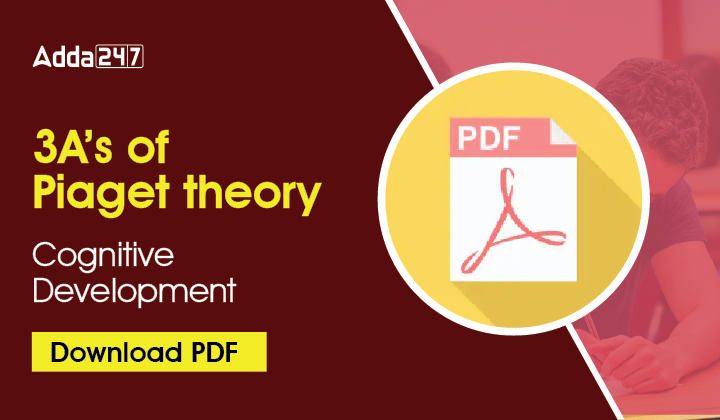Table of Contents
Piaget’s theory of cognitive development is a well-known and influential theory in the field of child development. According to Piaget, children progress through a series of distinct cognitive stages as they grow and develop. Piaget’s theory has been influential in the field of child development, and has helped researchers and educators better understand how children learn and develop. Here we are going to explain 3A’s of Piaget theory of Cognitive Development for Teaching Exam preparation.
3A’s of Piaget theory of Cognitive Development
संज्ञानात्मक विकास के पियाजे के सिद्धांत के 3 A
Piaget theory of cognitive development has used the following two steps or activities i.e., organisation and adaptation which have been described as follows: संज्ञानात्मक विकास के पियाजे सिद्धांत ने निम्नलिखित दो चरणों या गतिविधियों का उपयोग किया है अर्थात्, संगठन और अनुकूलन जिनका वर्णन निम्नानुसार किया गया है:
Adaptation
According to Piaget, children have inborn tendency of adjustment to their environment. This is tendency has been termed as ‘adaptation’. According to him, the child starts adaptation with the environment right from the beginning. अनुकूलन: पियाजे के अनुसार, बच्चों में अपने वातावरण में समायोजन की जन्मजात प्रवृत्ति होती है। इस प्रवृत्ति को ‘अनुकूलन’ की संज्ञा दी गई है। उनके अनुसार, बच्चा शुरू से ही वातावरण के साथ अनुकूलन करना शुरू कर देता है.
Organisation: When a child faces any stimulating situation, then his different mental activities do not work separately, but they function simultaneously and collectively help him in acquiring knowledge. At mental level, this activity continuously occurs. Adaption to environment is the result of the organisation. संगठन: जब कोई बच्चा किसी उत्तेजक स्थिति का सामना करता है, तो उसकी अलग-अलग मानसिक गतिविधियाँ अलग से काम नहीं करती हैं, लेकिन वे एक साथ काम करते हैं और सामूहिक रूप से ज्ञान प्राप्त करने में उसकी मदद करते हैं। मानसिक स्तर पर, यह गतिविधि लगातार होती रहती है। पर्यावरण के प्रति अनुकूलन संगठन का परिणाम है।
Hence, organisation and adaptation are complementary processes to each other. The relationship of a person with the environment affects the organisation internally while adaptation influences externally. इसलिए, संगठन और अनुकूलन एक दूसरे के पूरक प्रक्रियाएं हैं। पर्यावरण के साथ एक व्यक्ति का संबंध आंतरिक रूप से संगठन को प्रभावित करता है जबकि अनुकूलन बाहरी रूप से प्रभावित करता है
Sub – processes of Adaptation : According to Piaget, adaptation has two subprocesses of assimilation, or we can say that this process of understanding & change involves two basic functions, such as – अनुकूलन की उप-प्रक्रियाएं: पियाजे के अनुसार, अनुकूलन में आत्मसात के दो उपप्रकार हैं, या हम कह सकते हैं कि समझ और परिवर्तन की इस प्रक्रिया में दो बुनियादी कार्य शामिल हैं, जैसे
(a) Assimilation आत्मसात्करण (b) Accommodation समायोजन
Assimilation
Assimilation is such a process in which the child takes the help of earlier learned strategies or mental processes. It is a biological process. According to Piaget, from a biological point of view, assimilation is the integration of external elements into evolving or completed structures of an organism. आत्मसात्करण एक ऐसी प्रक्रिया है जिसमें बच्चा पहले से सीखी गई रणनीतियों या मानसिक प्रक्रियाओं की मदद लेता है। यह एक जैविक प्रक्रिया है। पियाजे के अनुसार, एक जैविक दृष्टिकोण से, आत्मसात एक जीव के विकसित या पूर्ण संरचनाओं में बाहरी तत्वों का एकीकरण है।
Example: when a person takes his meals, it does not stay basically in the body. The blood made out of meals is absorbed in the muscles in such a way that the shape of muscles changes. This makes clear that as a result of the process of assimilation structural changes occur. उदाहरण: जब कोई व्यक्ति अपना भोजन लेता है, तो यह मूल रूप से शरीर में नहीं रहता है। भोजन से बना रक्त मांसपेशियों में इस तरह अवशोषित होता है कि मांसपेशियों का आकार बदल जाता है। यह स्पष्ट करता है कि आत्मसात की प्रक्रिया के परिणामस्वरूप संरचनात्मक परिवर्तन होते हैं
- Assimilation describes humans perceive and adapt to new information.
- It is the process of taking one’s environment and new information and fitting it into pre – existing schemas.
- Assimilation occurs when humans are faced with new or unfamiliar information and refer to previously learned information in order to make sense of it.
- आत्मसात्करण मनुष्यों के अनुभवों का वर्णन करता है और नई जानकारी के अनुकूल होता है।
- यह किसी के पर्यावरण और नई जानकारी लेने और इसे पहले से मौजूद स्कीमा में फिट करने की प्रक्रिया है।
- आत्मसात्करण तब होता है जब मनुष्यों को नई या अपरिचित जानकारी का सामना करना पड़ता है और इसे समझने के लिए पहले से सीखी गई जानकारी को संदर्भित करता है
Accommodation
Accommodation is that process which occurs when the pre-learned strategies or mental processes are not workable. According to Piaget child makes balance between the processes of assimilation and accommodation. When a child faces new problem, then cognitive disequilibrium is created, and the child starts his efforts to remove that cognitive disequilibrium, both the processes of assimilation or accommodation. समायोजन: समायोजन वह प्रक्रिया है जो तब होती है जब पूर्व-सीखी गई रणनीतियाँ या मानसिक प्रक्रियाएँ व्यावहारिक नहीं होती हैं। पियाजे के अनुसार, बच्चा आत्मसात और आवास की प्रक्रियाओं के बीच संतुलन बनाता है। जब एक बच्चा नई समस्या का सामना करता है, तो संज्ञानात्मक असमानता पैदा होती है, और बच्चा उस संज्ञानात्मक असमानता को दूर करने के लिए अपने प्रयासों को शुरू करता है, आत्मसात या समायोजन की प्रक्रिया
- Accommodation is the process of taking one’s environment and new information, and altering one’s pre – existing schemas in order to fit in the new information.
- Accommodation is imperative because it is how people will continue to interpret new concepts, schemas, framework etc.
- समायोजन किसी की पर्यावरण और नई जानकारी लेने की प्रक्रिया है, और नई जानकारी में फिट होने के लिए पहले से मौजूद स्कीमा को बदलना है।
- समायोजन अनिवार्य है क्योंकि यह है कि कैसे लोग नई अवधारणाओं, स्कीमा, रूपरेखा आदि की व्याख्या करना जारी रखेंगे
CDP Study Notes For All Teaching Exams
Process of Development
Other Terms: अन्य पद:
Schemas: Piaget called the schemas the basic building block of intelligent behaviour, a way of organizing knowledge. स्कीमा: पायगेट ने स्कीमाओं को ज्ञान के आयोजन का एक तरीका, बुद्धिमान व्यवहार का बुनियादी निर्माण खंड कहा है.
- It is useful to think of schemas as “units” of knowledge, each relating to one aspect of the world, including objects, action & abstract (i.e. theoretical) concepts. यह स्कीमा को ज्ञान की “इकाई” के रूप में सोचने के लिए उपयोगी है, प्रत्येक वस्तु, कार्रवाई और अमूर्त (यानी सैद्धांतिक) अवधारणाओं सहित दुनिया के एक पहलू से संबंधित है
- A schema can be defined as set of linked mental representations of the world, Which we use both to understand and to respond to situations. एक स्कीमा को दुनिया के जुड़े हुए मानसिक अभ्यावेदन के सेट के रूप में परिभाषित किया जा सकता है, जिसका उपयोग हम समझने और स्थितियों का जवाब देने के लिए करते हैं
For example, a person might have a schema about buying a meal in a restaurant. The schema is a stored form of the pattern of behaviour which includes looking at a menu, ordering food, eating it and paying the bill. This is an example of a type of schema called a ‘Script’. उदाहरण के लिए, किसी व्यक्ति के पास रेस्तरां में भोजन खरीदने के बारे में स्कीमा हो सकती है। स्कीमा व्यवहार के पैटर्न का एक संग्रहीत रूप है जिसमें एक मेनू को देखना, भोजन का आदेश देना, उसे खाना और बिल का भुगतान करना शामिल है। यह एक प्रकार के स्कीमा का उदाहरण है जिसे ‘स्क्रिप्ट’ कहा जाता है
Equilibration
Equilibration is the forced which moves development along. Piaget believed the cognitive development did not progress at a steady rate, but rather in leaps and bounds. Equilibrium occurs when a child’s schemas can deal with most new information through assimilation. However, an unpleasant state of disequilibrium occurs when new information cannot be filled into existing schemas (assimilation). संतुलन: संतुलन बलपूर्वक होता है जो विकास को साथ ले जाता है। पियाजे का मानना था कि संज्ञानात्मक विकास एक स्थिर दर पर नहीं हुआ, बल्कि छलांग और सीमा में हुआ। संतुलन तब होता है जब किसी बच्चे का स्कीमा अधिकांश नई सूचनाओं को आत्मसात कर सकता है। हालाँकि, असमानता की एक अप्रिय स्थिति तब होती है जब नई जानकारी को मौजूदा स्कीमा (आत्मसात) में नहीं भरा जा सकता है।
Disequilibrium
When a child’s experience matches what they understand they are in a state of equilibrium. If they come across a new situation or task that they do not understand, Piaget called this disequilibrium. This occurs when a child is unable to use existing schema to understand new information to make sense of objects and concepts. असंतुलन: जब किसी बच्चे के अनुभव से मेल खाता है, तो वे समझते हैं कि वे संतुलन की स्थिति में हैं। यदि वे एक नई स्थिति या कार्य में आते हैं जो उन्हें समझ में नहीं आता है, तो पियाजे ने इसे असंतुलन कहा। यह तब होता है जब कोई बच्चा वस्तुओं और अवधारणाओं की समझ बनाने के लिए नई जानकारी को समझने के लिए मौजूदा स्कीमा का उपयोग करने में असमर्थ होता है।



 CU Rajasthan Professor Recruitment 2024,...
CU Rajasthan Professor Recruitment 2024,...
 KTET 2024 Notification Out, Exam Date, E...
KTET 2024 Notification Out, Exam Date, E...
 MPPSC Assistant Professor Selection Proc...
MPPSC Assistant Professor Selection Proc...








